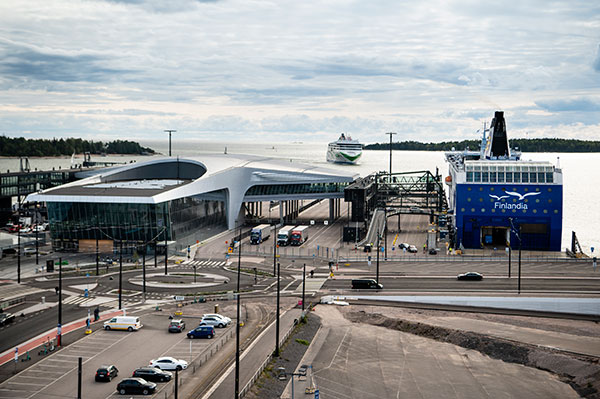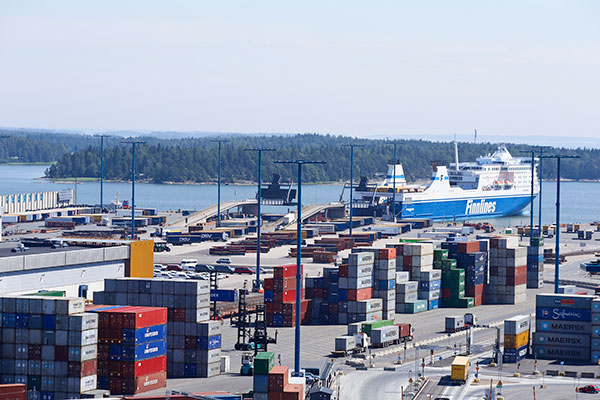Environment
Ports
Wanted: More sustainable ports

photo: PORT OF HELSINKI / VEIKKO SOMERPURO
When talking about sustainability in maritime, one can hardly ignore the ports. In the EU alone, there are over one thousand ports, handling goods in the excess of 4 billion tonnes. But just how green are
they?
In addition to being a vital link in the
worldwide shipping logistics chain, the
ports play a key role in assuring a greener
maritime sector. Ports handle and dispose
waste from ships and can facilitate the
use of alternative fuels and energy supplies.
Through port call optimization, ship
time spent at berth can be minimized, thus
reducing the generation of associated air
emissions. Lately, onshore power supply
(OPS) has become a big driver in the Green
Ports agenda.
Andreas Slotte, Head of Sustainability
at the Port of Helsinki, points out
that as EU’s Fit for 55 regulation package
is now taking shape, one key aspect of the
package concerns onshore power supply.

“During the last five years we’ve build our OPS system to full coverage – and it’s something the
liner vessels really appreciate, since these ships require lots of power and call on Helsinki daily,”
Andreas Slotte, Head of Sustainability at the Port of Helsinki says.
photo: ANDREAS SLOTTE
“Onshore power supply will be mandatory
from the year 2030 onwards, for
some segments,” Slotte says, adding that
Port of Helsinki has been perfecting its own
OPS solution in recent years: for example,
in 2021 the LJ7 and LJ8 berths at West Harbour
were equipped with onshore power
connections and OPS at South Harbour
was completed, as well.
“During the last five years we’ve
build our OPS system to full coverage –
and it’s something the liner vessels really
appreciate, since these ships require lots of
power and call on Helsinki daily,” he says.
GREEN CORRIDOR FOR TWIN CITIES
In October 2023, it was announced that
Helsinki and Tallinn will create a Green Corridor
to ensure and accelerate the creation
of a climate neutral customer journey
and maritime Green Corridor between
Helsinki – Tallinn and Vuosaari – Muuga
connections.
This Green Corridor is a shipping
route and an umbrella for several projects
at sea, and in shore operations in Helsinki
and Tallinn, which aim to reduce emissions
and increase the use of solutions of zero (or near zero) emissions. The partners in
the Green Corridor initiative are the cities
and the ports of Helsinki and Tallinn, Rederi
AB Eckerö, Tallink Grupp and Viking Line
as well as the Estonian Ministry of Climate.
Andreas Slotte notes that, currently,
Green Corridors are being set up around
the world, but rarely with so many committed
partners: typically, you have two
ports and a shipping line in the venture.
“In this Finland – Estonia Green
Corridor, there are three shipping companies which are competitors as such –
but still want to contribute to sustainability
together. That’s pretty rare and really
quite fantastic,” Slotte says.

photo:
PORT OF HELSINKI / JARMO VEHKAKOSKI
ACCELERATE GREEN
TRANSITION
This Green Corridor is an active one, since
there are annually 9 million passengers and
2 million vehicles crossing the sea between
Helsinki and Tallinn. While ferry business is
still seen as a necessity for the well-being
of the “Twin Cities,” reduction of greenhouse
gas emissions has become an urgent
issue for all parties involved.
The goal of this Green Corridor is to
boost the transition to a climate neutral
and sustainable customer journey for both
passengers and cargo of the related sea
routes. This means that there will be joint
roadmaps for shipping companies, cities and ports with founding – and other partners
– to assist them with achieving zeroemission
(and other) goals.
Activities within the Green Corridor
are geared towards climate neutrality and,
at the same time, increasing of passenger
and cargo flow between the two countries.
In addition, it is vital to strengthen
the competitiveness and vitality of the corridor
as well as to have some joint scientific
studies carried out to enhance project
activities and increase knowledge and knowledge-sharing. Joining relevant international
initiatives for the development of
Green Corridors is also being prepared as
part of the venture.
STREAMLINING EFFORTS CONTINUE
Andreas Slotte reports that, of late, Port
of Helsinki has been achieving other
green goals, too. The TWIN-PORT III and
TWIN-PORT IV projects, partly funded
by the EU, were completed this year at
Port of Helsinki.
The projects led to various improvements, the common thread of
which was the pursuit of responsible, efficient
and modern port operations and, in
particular, the streamlining of ship traffic
between Helsinki and Tallinn.
In fact, the name ‘TWIN-PORT’
refers to the shipping and port operations
between Finland and Estonia via the ports
of Helsinki and Tallinn.
“We have installed, for example,
double ramps which are a very green
investment as such, since they shorten
the time in port, which in turn enables a
more fuel-efficient sea voyage,” explains
Slotte. In addition, a new Smart Port gate system for vehicles at West Harbour and
Katajanokka was introduced at the beginning
of summer 2023.

photo: PORT OF HELSINKI / VEIKKO SOMERPURO
STAY RELEVANT!
According to Slotte, adapting to a new,
more sustainable world is simply “a must”
for all the actors of the sector.
“Those who don’t pay attention to
sustainability will become irrelevant rather
soon,” he says, adding that all players
must show initiative in their green pursuits
and continue to go deeper and wider.
“Also, the long-term competitiveness
of ports, for example, will benefit from a more sustainable approach, even if there
are costs involved in the short term.”
Sustainability is already a cornerstone
of many a strategy drawn up by the maritime
companies in recent times – and this
trend will only continue and strengthen.
“Shipping companies are heavily focused
on sustainability. We are not going to be
an interesting partner for them if we do
nothing.”
In trying times, there’s not much
money to go around – so is sustainability
facing headwinds that it can’t overcome
right now? – Slotte feels that the answer
may lie in allocating resources more wisely.
“Green investments may not take
a hit, if prioritizing is made right. Futureproofing
the business must be on everybody’s
agenda in any case,” he encourages.
PORT OF HELSINKI: TARGETING CARBON-NEUTRALITY
25 % reduction in vessel emissions by the year 2030
- Shore power capabilities for several berths
- Making alternative fuels available at Helsinki ports
- The continued development of an environmental program targeted
at ships
60 % reduction in emissions from heavy goods vehicles by 2030
- Minimizing the use of transport vehicles at ports
- Introducing incentives to use low-emission vehicles
60 % reduction in emissions from work machines used in the harbor area by 2030
- Enabling the electrification of work machine infrastructure
- Encouraging the use of biofuels
The Port of Helsinki should be 100% carbon neutral in terms of its own emissions by 2025
- Minimizing the Port’s energy consumption by modernizing heating, installing LED lighting, and increasing the use of solar panels
- Acquiring necessary energy from carbon-free sources
- Helping to lower subcontractors’ carbon footprints via procurement
by: Sami J. Anteroinen



